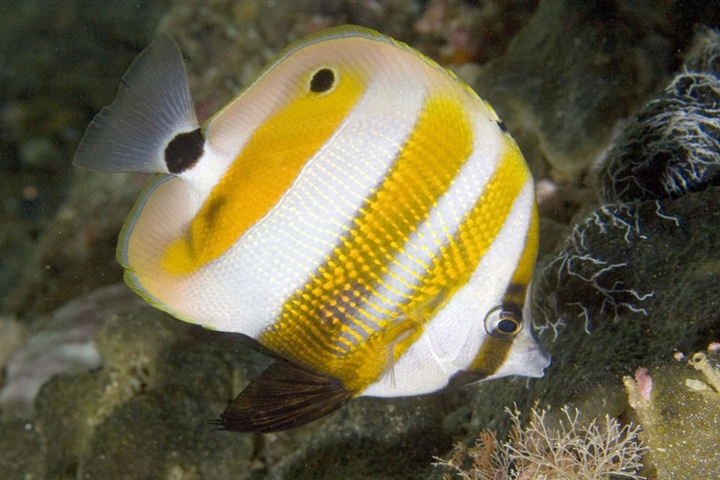Coradion chrysozonus


| Latin name | Coradion chrysozonus - (Cuvier, 1831) |
|---|---|
| Local name | Goldengirdled coralfish |
| Family | Chaetodontidae - Coradion |
| Origin | East Indian Ocean, Australia, Indonesia, Central/West Pacific |
| Max length | 15 cm (5.9") |
| Minimum volume |
300 l (79 gal) |
|---|---|
| Hardiness |
Average |
| Suitable for aquarium |
Suitable for special aquariums |
| Reef safe |
Often reef safe |
| Aggressiveness | Peaceful |
| Recommended |
Microalgea (Eg. spirulina) Small crustaceans (Krill, mysis, artemia...) Zooplankton (Cyclops, pods...) |
|---|---|
| Maybee |
Large polyp stone coral (LPS) Soft coral |
This species likes to eat tubeworms.
This species sometimes nibbles at clams including Tridacna species.
This species lives in water colder than is the norm for a marine aquarium.
The temperature should be between 21 and 24°C (70 and 75 °F).
They can live as a pair provided they are introduced simultaneously.
This species is very shy and docile, so one should be careful when keeping it with more aggressive fish.
The Butterflyfish are known for their attractive patterns and colours. They are closely related to Angelfishs, but can always be distinguished, as they lack the spines on each side of the head of the Angelfish.
A smaller group of these fish will seek out primairily soft corals, like Zoanthus. A larger part of the species will target different types of LPS corals. Butterflyfish are also known to seek out anemones, tubeworms and bristleworms.
Therefore it is important to choose the correct species in relation to the corals wanted, if one desires to keep Butterflyfish in a coral-aquarium.
Bristleworms, tubeworms and other small invertebrates are also a part of the diet for many Butterflyfish.
It can be problematic, with many of these species, to get them eating in the beginning, but many of the species cannot resist live zooplankton or live mussels with crushed shells. Another option is to mimic their natural behaviour by stuffing their food into coral skeletons or stones.
They ignore most other fish and are generally peaceful, therefore multiple Butterflyfish will have no problem living together. One should however be cautious about keeping similar species together unless they are a couple.
As these fish can be difficult to acclimatize and get feeding, it is important to buy healthy fish, to avoid having to deal with more problems. Make sure to check that they do not have parasites or any visible infections.
There are some species that should not be kept in an a aquarium, as they are food specialists and will almost always refuse to eat replacement foods. It can be possible to breed some species, which will eat frozen foods. Otherwise the only way to keep food specialists is by feeding them their natural diet, which consists of live SPS or LPS corals for example.
| Aquarium trade | Yes |
|---|---|
| Distribution | Indo-Pacific: scattered colonies along the coast of Queensland, the Frankland Group off north Queensland, Western Australia, and New Guinea; Indonesia and the Philippines, and very seldom along the Chinese coast. Recently reported from Tonga (Ref. 53797 |
| French common names |
Coradion à bandes orange |
| English common names |
Goldengirdled coralfish Golden-girdled coralfish Orange-banded coralfish Orangebanded coralfish |
| Danish common names |
Bæltefanefisk |
Scott W. Michael. 2004. Angelfishes and Butterflyfishes (Reef Fishes Series Book 3) TFH Publications / Microcosm Ltd. - (English)
Bob Fenner. Butterflyfishes; Separating the Good Ones and Those You Don't Want - Wet Web Media - (English)
Collection of links to additional information - Wet Web Media - (English)
Tea Yi Kai. 2014. Reef Nuggets 2: Aquatic Lepidopterans for your reef (Revised edition) - Reef Builders - (English)

